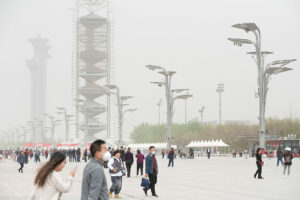SCORCHING temperatures are roasting Asia this week, stretching the region’s power grids and raising health risks as the chances of more extreme events later in the year increase.
The worst drought in a decade is impacting a key Chinese aluminum hub, while searing temperatures in India have increased the possibility of deadly heat waves and blackouts. Thailand hit a national record of more than 45°C (113F) last week, while countries such as Bangladesh are also seeing April temperatures well above 40°C.
While this time of year is typically the hottest for India and parts of Southeast Asia, the soaring temperatures continue a pattern of severe weather over the past several years that’s testing the ability of governments to protect public health and prevent disruptions to recovering economies. India’s heat waves are making its people more vulnerable to illness and hunger, holding back the development of Asia’s third-largest economy, according to a new study.
“Record heat in Thailand, China and South Asia is a clear climate trend and will cause public health challenges for years to come,” said Fahad Saeed, an Islamabad-based scientist with Climate Analytics.
Extreme weather has become more frequent due to climate change, and the world has just endured two years of La Nina — which led to flooding in Pakistan and drought in South America. It’s also possible there will be another El Niño even this year, which would bring drier conditions to parts of Asia.
The impact from severe weather in Asia threatens to reverberate beyond the region. China and Vietnam are the production centers for much of the world’s goods from electronics to clothing, and the extreme heat and drought comes just as nations are beginning to rebound from the COVID pandemic.
China, which only dismantled its restrictive COVID Zero policy a few months ago, has seen major disruptions to industrial production in recent years because of extreme weather. It was gripped by a severe drought last year that impacted the Yangtze River — a key conduit used to irrigate farms and power the massive Three Gorges Dam power station.
Yunnan province, in the southwest of the country, has been affected by drought conditions for some months, leading to cuts in aluminum production since September due to lower hydropower output. China, along with India, is leaning on coal to ensure reliable electricity supply.
Yet each day India’s heat wave continues increases the chances of depleting the nation’s reserves of the fuel. The government has warned of blackouts as hotter temperatures prompt higher use of air conditioners and pumps for irrigation. A heat wave in 2022 caused widespread suffering and affected wheat supplies.
Asia has been lashed by other types of wild weather lately, from a sandstorm that originated in Mongolia and China and also affected South Korea and Japan, to the biggest cyclone to hit Western Australia in more than a decade.
Weather woes have filtered through to stock markets as investors fret about the impact. India’s heat is threatening production in the world’s largest milk-producing nation, pushing up dairy stocks, while shares of agricultural firms in Thailand are in focus on expectations for hotter and drier weather.
Australian farmers are also facing hotter weather in the coming months. They typically start planting wheat in April, with a bumper harvest last season helping to offset some of the losses caused by the Russia’s war in Ukraine. Recent rains will ensure a good start to the season, but drier conditions may impact the crop later in the year.
“The critical period will be August-September, given we have enough moisture to get us that far,” said Ole Houe, chief executive officer of Sydney-based broker and adviser IKON Commodities. — Bloomberg

